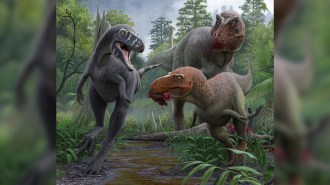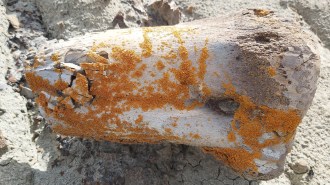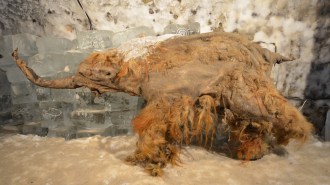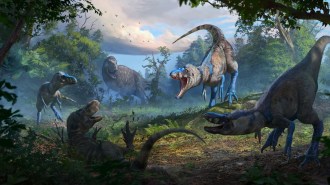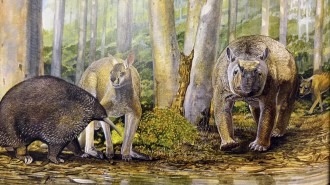Did fibers and filaments become feathers?
A variety of filamentary structures on the fossil of a small theropod dinosaur found in China may provide new insight into the evolution of feathers, say the scientists who unearthed the remains.


The researchers haven’t been able to identify the species of the dinosaur because many of the fragile bones in the 60-centimeter-long fossil shattered when the slab containing the remnant was split apart. Still clearly evident in the fine-grained sediments that entombed the small, ground-dwelling raptor, however, are the fibers, filaments, and other structures that covered the animal’s body, says Mark A. Norell, a paleontologist at the American Museum of Natural History in New York. He and his colleagues describe the fossil in the April 26 Nature.
A thick mat of single filaments at least 2 cm long coated the dinosaur’s head. Longer versions of these hairlike fibers graced the nape of the animal’s neck, says Norell. Long, thin, branched filaments — think of them as a really bad case of prehistoric split ends — covered the animal’s shoulders, body, and upper hind limbs.
Evidence of a third type of body covering, the type that Norell and his colleagues say is the most interesting, extends as much as 5.2 cm from the fossil’s forelimbs. In this area, the fibers seem to branch from a central axis in a herringbone pattern akin to that seen in modern feathers.
Larry D. Martin, a paleontologist at the University of Kansas in Lawrence, says he’s “quite puzzled” by the distribution of the filaments, especially in areas around the animal’s hind limbs. He notes that in many places on the fossil, the filaments seem to extend all the way to the bone, leaving no room for muscle, skin, or other tissue.
That’s not all that needs explaining. “I don’t know of any animal with feathers or such long hair on its thighs like that,” Martin says. “This is funny stuff.”
Because the ages of the sediments encasing the find have yet to be determined, the scientists don’t know exactly how old the fossil is, says Norell. However, the ages of similar rocks from formations about 130 kilometers away suggest the toothy raptor stalked the Asian landscape between 147 million and 126 million years ago.
The new find joins a plethora of feather-bearing species that have been extracted from sediments in the same area of China, notes Hans-Dieter Sues, a paleontologist at the University of Toronto.
Several types of fibers and filaments found on the fossil show characteristics that fit into one proposed theory about the origin of modern feathers (SN: 3/10/01, p. 149), says Sues. Furthermore, this flightless dinosaur is evidence that there was a definite separation between the evolution of feathers and of flight.
“It’s gratifying to have evidence of a ground-dwelling dinosaur with feathers,” says Sues. The fossil record of the millions of years during which feathered dinosaurs developed into modern birds is one of the few well-documented examples of evolution that include several intermediate stages, he adds.

